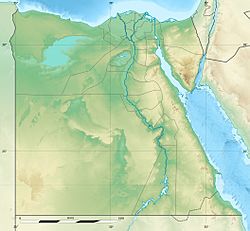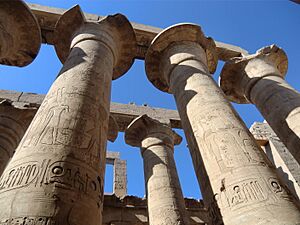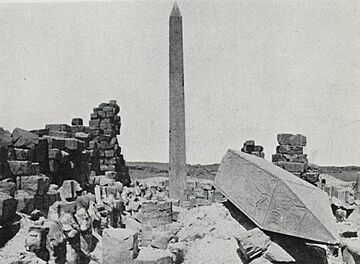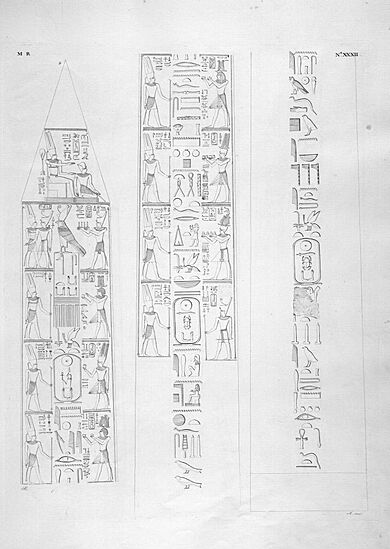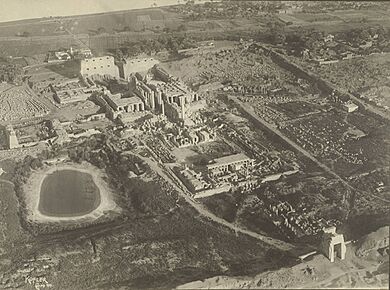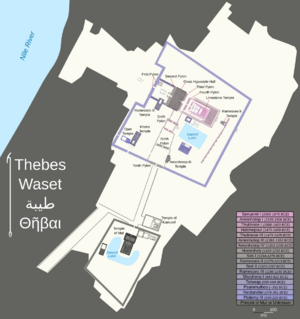Karnak facts for kids
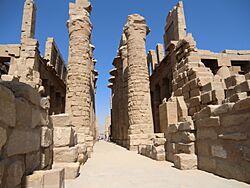
Pillars of the Great Hypostyle Hall from the Precinct of Amun-Re
|
|
| Location | El-Karnak, Luxor Governorate, Egypt |
|---|---|
| Region | Upper Egypt |
| Coordinates | 25°43′7″N 32°39′31″E / 25.71861°N 32.65861°E |
| Type | Sanctuary |
| Part of | Thebes |
| History | |
| Builder | Senusret I–Nectanebo I |
| Material | Stone |
| Founded | c. 1970 BCE |
| Periods | Middle Kingdom to Ptolemaic Kingdom |
| Site notes | |
| Condition | Ruin |
| Public access | Yes |
| Official name | Ancient Thebes with its Necropolis |
| Type | Cultural |
| Criteria | I, III, VI |
| Designated | 1979 (3rd session) |
| Reference no. | 87 |
| Region | Arab states |
The Karnak Temple Complex, often just called Karnak, is a huge group of temples, tall gateways (called pylons), chapels, and other ancient buildings. It is located near the city of Luxor in Egypt. Building at Karnak started around 1970 BCE during the reign of Senusret I. Construction continued for many centuries, even into the Ptolemaic Kingdom (305–30 BCE). Most of the buildings you see today are from the New Kingdom.
In ancient Egypt, the area around Karnak was known as Ipet-isut, which means "The Most Selected of Places." It was the main place of worship for the gods of Thebes, especially the god Amun. Karnak is part of the ancient city of Thebes. In 1979, UNESCO added it to the World Heritage List. The modern name "Karnak" comes from a nearby village called El-Karnak.
Contents
What's in the Karnak Complex?
The Karnak complex is a very large open area. It even includes the Karnak Open Air Museum. It is one of the most visited historical sites in Egypt. Only the Giza pyramid complex gets more visitors each year.
Karnak has four main parts. However, only the largest part is open to the public. This main part is called the Precinct of Amun-Re. Most visitors only see this section. The other three parts are the Precinct of Mut, the Precinct of Montu, and the Temple of Amenhotep IV. These are currently closed to visitors. There are also smaller temples that connect the different areas.
What makes Karnak special is how long it was built and used. Temple construction began in the Middle Kingdom and continued for over 1,500 years. About 30 different pharaohs added to the buildings. This made Karnak incredibly large and diverse. While some features are found elsewhere, the sheer size and number of them at Karnak are unique.
The Great Hypostyle Hall
The Great Hypostyle Hall is in the Precinct of Amun-Re. It is a massive hall with 134 huge columns. These columns are arranged in 16 rows. One hundred and twenty-two of these columns are 10 meters (33 feet) tall. The other 12 columns are even taller, reaching 21 meters (69 feet). They are also over 3 meters (10 feet) wide.
The large stone beams on top of the columns are called architraves. These beams are estimated to weigh 70 tons. Imagine how hard it was to lift them so high! One idea is that ancient Egyptians used levers. This would have been a slow process needing great balance. Another idea is that they built large ramps out of sand, mud, brick, or stone. Then, they would have pulled the huge stones up the ramps.
There is an unfinished pillar at Karnak. It shows how the carvings were done. The final details were carved after the column pieces were put in place. This protected the carvings during construction. Scientists have done experiments to move huge stones using ancient methods. Some of these stones are among the largest in the world.
The sun god's shrine at Karnak was built in a special way. Light from the sun shines directly on it during the winter solstice. This is the shortest day of the year.
Karnak's Long History
The history of Karnak is closely linked to the city of Thebes. As Thebes became more important, so did its religious centers. The city of Thebes was not very important before the Eleventh Dynasty. Early temples there were small. They were dedicated to local gods like Mut and Montu.
The earliest artifact found at Karnak is a small column from the Eleventh Dynasty. It mentions Amun-Re. Amun was the main god of Thebes. He was often shown as a ram or a goose. His name means "hidden god."
Most of the major building at Karnak happened during the Eighteenth Dynasty. This was when Thebes became the capital of ancient Egypt. Almost every pharaoh from this time added something to the temple. Thutmose I built a wall connecting two large gateways (pylons). These are still standing today.
Hatshepsut built many monuments. She also restored the ancient Precinct of Mut. This area had been damaged by foreign rulers. Hatshepsut put up two tall obelisks at the temple entrance. They were the tallest in the world at that time. One obelisk still stands. The other one fell and broke.
Hatshepsut also built the Red Chapel (or Chapelle Rouge). This was a special shrine for a sacred boat. She later ordered two more obelisks to celebrate her 16th year as pharaoh. One broke while being built. So, a third one was made to replace it. The broken obelisk is still at the quarry in Aswan. It helps us understand how obelisks were carved.
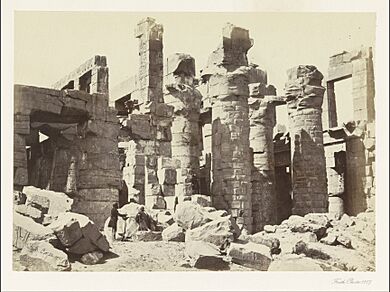
The Great Hypostyle Hall might have started in the Eighteenth Dynasty. But most of it was built by Seti I and Ramesses II in the Nineteenth Dynasty. Merneptah, another pharaoh, recorded his victories on the walls of the Cachette Court. This court was the start of the path to the Luxor Temple.
The last big change to the Precinct of Amun-Re was the First Pylon. This huge gateway and the walls around the precinct were built by Nectanebo I. He was from the Thirtieth Dynasty.
After Egypt became part of the Roman Empire, things changed. In 323 AD, Roman Emperor Constantine the Great made Christianity a recognized religion. In 356 AD, Constantius II ordered all pagan temples closed. By then, Karnak was mostly empty. Christian churches were built among the ruins. A good example is the Festival Hall of Thutmose III. You can still see paintings of saints and Coptic writing there.
How Europeans Learned About Karnak
For a long time, people in medieval Europe did not know exactly where Thebes was. Even though ancient writers like Herodotus described its location. Maps based on Claudius Ptolemaeus' work showed Thebes. But some European travelers still thought it was near Memphis.
The first European to describe the Karnak temple complex was an unknown Venetian in 1589. His writings are in a library in Florence, Italy. He did not give the complex a name.
The name "Karnak" for the village and the complex first appeared in 1668. Two missionary brothers, Protais and Charles François d'Orléans, traveled through the area. Their travel stories were later published.
The first drawing of Karnak was made by Paul Lucas in 1704. It is not very accurate. It shows a mix of different parts of the complex. Many other explorers and scientists visited Karnak later. These included people from Napoleon's expedition in the late 1700s.
Main Parts of Karnak
Precinct of Amun-Re
This is the biggest part of the temple complex. It was built for Amun-Re, the most important god of Thebes. It has many huge statues. One statue of Pinedjem I is 10.5 meters (34 feet) tall. The sandstone for this temple came from Gebel el-Silsila, about 100 miles (160 km) south. It also has one of the largest obelisks. This obelisk weighs 328 tons and stands 29 meters (95 feet) tall.
Precinct of Mut
This area is south of the Amun-Re complex. It was dedicated to the mother goddess, Mut. She was seen as the wife of Amun-Re. This precinct has smaller temples and its own sacred lake. The lake is shaped like a crescent moon. Much of this temple was damaged. Parts of it were used to build other structures.
After being excavated and restored, the Precinct of Mut is now open to the public. Six hundred black granite statues were found in the temple courtyard. This might be the oldest part of the entire Karnak site.
Precinct of Montu
This part of the site is dedicated to Montu. He was the son of Mut and Amun-Re, and a god of war. It is north of the Amun-Re complex and is much smaller. This area is not open to the public.
Temple of Amenhotep IV (Dismantled)
The temple built by Akhenaten (Amenhotep IV) was east of the main complex. It was outside the walls of the Amun-Re precinct. This temple was destroyed right after Akhenaten died. He had tried to change the religion and reduce the power of the priests. The temple was so completely taken apart that we don't know its full size or layout. The priests regained their power after Akhenaten's death. They worked hard to erase many records of his rule.
Images for kids
See also
 In Spanish: Karnak para niños
In Spanish: Karnak para niños


